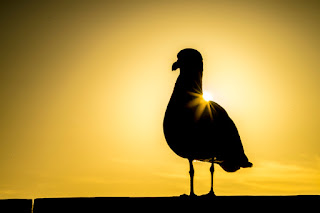Convergence - Disparate elements coming together at the same point. The fracturing of sunlight at the hard edge. Fingers connecting to a hard edge of stone.. The super moon falling closer in the sea of sky... A coalescing, a promise in the making.
It has been a strange couple of weeks for me. Creativity, pain, hope - all colliding in more intense ways than I might ever have imagined. My own satellite finally escaping it's internal corporeal orbit, a stone from my kidney that's final release coincided with this super moon. A star wars style laser finishing it.
Tuesday I wandered the pier at twilight as the sun rose and the giant moon set. My kidney and bladder and ureter still aflame, my mind a jumble from heavy narcotics. Alone, in the company of sea birds, I released a red stream of bloody urine into the hissing sea, said goodbye to bits of blasted stone, to blinding agony.
I kept quiet company with the resting birds as the morning drew on and the golden light crescendoed. My camera, this ocular eye of eye, grounding me and setting me free. All voice, vision, breath - caught, held, exhaled. Again. And again.
all images ©Bennett Barthelemy November 2016
























